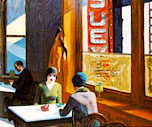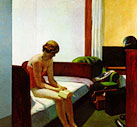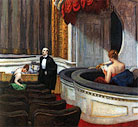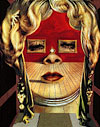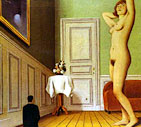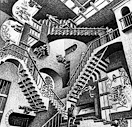|
Artists Mulholland Dr. is influenced by |
|
|
Edward Hopper |
|
|
|
Salvador Dalí
|
|
René
Magritte |
|
|
|
M.C.
Escher |
|
I can see clearly a connection between David
Lynch’s movie and M.C. Escher's art. Both artists confuse, instigate
our senses; it's hard to find a connection in both works of art that
"fulfills", follows our logical reasoning. Escher
uses his Architecture and Mathematics knowledge to create an impossible
perspective, an illusion, in "Waterfall or Belvedere"
lithographies, for example. |
|
|
Religious References |
|
|
|
Image
at Park Hotel room |
Buddhism in Mulholland Dr.
iIf you look at Mulholland Drive
with Buddhism in mind, it makes a bit more sense...
The Club Silencio scene is where all this elements come together... the process
of dying begins.
First of all, Club Silencio, just like the red room in Twin Peaks, is like a
transit lounge, a waiting room … in which one must wait up to forty nine days
before transferring to the next life … this process is called the bardo of
becoming … where we have a mental body that is endowed with immense clarity
and unlimited mobility, yet the direction in which it moves is determined solely
by the habitual tendencies of our past karma … we are simply buffeted around
by the force of karma.
During the first weeks of the
bardo, we may not realize we are dead. We return to our home, our daily lives
only to discover that no one notices you, you are ignored, you don't exist. We
feel angry, hurt. If we are very attached to our body, we may even try to
reenter or hover around it. In extreme cases the mental body can linger near its
possessions or body for weeks. And still it may not dawn on us that we are dead.
It is only when we see that we make no reflection in the mirror, cast no shadow
that we finally realize. And the sheer shock of recognizing we have died can be
enough to make us faint away. Some can even get stuck in the bardo, to become
spirits or ghosts.
In the bardo of becoming we relive
all experiences of past life, minute details and revisiting places. Every seven
days we are compelled to go through the experience of death once again … Our
restless, solitary wondering through the bardo world is as frantic as a
nightmare, just as in a dream, we believe we have a physical body and that we
really exist.
When a person commits suicide, the consciousness has no choice but to follow its
negative karma, and it may well happen that a harmful spirit will seize and
possess its life force. Also, it talks about space being perceived as a blue
light. - (Joshieboyucla)
|
Related: |
